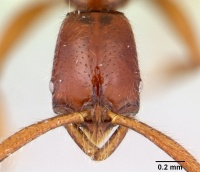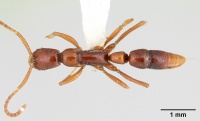Leptogenys foveonates
| Leptogenys foveonates | |
|---|---|

| |
| Scientific classification | |
| Kingdom: | Animalia |
| Phylum: | Arthropoda |
| Class: | Insecta |
| Order: | Hymenoptera |
| Family: | Formicidae |
| Subfamily: | Ponerinae |
| Tribe: | Ponerini |
| Genus: | Leptogenys |
| Species: | L. foveonates |
| Binomial name | |
| Leptogenys foveonates Lattke, 2011 | |
The type locality is cloud forest with trails that range in altitude from 1100 to 1400 m. These are probably rare ants since several intensive leaf litter sifting campaigns in the forests close to the Rancho Grande station and on the northern slopes of the national park have failed to recover any additional specimens of this species (Lattke 2011).
Identification
Lattke (2011) - Head elongate in full-face view, wider anterad than posterad; compound eye small, placed laterally on head, not more than 6 ommatidia in length; oculomalar distance greater than eye length; mesonotum almost 3 × wider than long in dorsal view; abdominal segments III and IV punctate. Even though it is described from a single specimen the ant is quite distinct on several accounts, not the least of which is the punctuate gaster, a rare sculpture for the New World members of the genus.
Keys including this Species
Distribution
Distribution based on Regional Taxon Lists
Neotropical Region: Venezuela (type locality).
Distribution based on AntMaps
Distribution based on AntWeb specimens
Check data from AntWeb
Countries Occupied
| Number of countries occupied by this species based on AntWiki Regional Taxon Lists. In general, fewer countries occupied indicates a narrower range, while more countries indicates a more widespread species. |

|
Estimated Abundance
| Relative abundance based on number of AntMaps records per species (this species within the purple bar). Fewer records (to the left) indicates a less abundant/encountered species while more records (to the right) indicates more abundant/encountered species. |

|
Biology
|
Castes
Queens and males are unknown.
Nomenclature
The following information is derived from Barry Bolton's Online Catalogue of the Ants of the World.
- foveonates. Leptogenys foveonates Lattke, 2011: 229, fig. 83 (w.) VENEZUELA.
Unless otherwise noted the text for the remainder of this section is reported from the publication that includes the original description.
The type locality is cloud forest with trails that range in altitude from 1100 to 1400 m. Girardot is the Municipality which once contained the Rancho Grande field station, but now the station is part of the Mario Briceño Irragory Municipality. A second specimen, from the IAvH collection, of a closely related species was studied but not described as it is lacks locality data save an altitude (1000 m) and some labels with codes. Fernando Fernández (Instituto de Ciencias Naturales, Universidad Nacional, Bogotá) kindly went through his field books and found data matching the codes on the specimen which indicate it probably is from Magdalena, Sierra Nevada de Santa Marta, 1992, perhaps close to San Pedro de la Sierra.
The size of the Colombian specimen is comparable but it is dark brown. The Colombian specimen has denser punctation on the abdomen, and has punctae where the Rancho Grande specimen does not: the cephalic ventral face as well as the mesosomal and petiolar dorsum. The punctae on the petiolar node and gaster are large, dense and elongate, giving the impression of sulci. The node is shaped differently in lateral view, with a concave posterior margin, and more elongate aspect, the subpetiolar process is also different. The metanotal groove is not as deeply impressed thus the whole mesosomal surface appears uniformly convex. More noticeably, the node is laterally rounded and not V-shaped as in the Venezuelan specimen, and the compound eye appears as a single large ommatidium. In L. foveonates the ommatidia are relatively indistinct and appear to be covered over by a single large lens.
The Colombian specimen most probably represents another species but given the similarities and the scant material it is best to wait until more specimens can be gathered.
Description
Worker
Metrics, holotype (Colombian specimen): HL 0.96 (0.98); HW 0.64 (0.68); ML 0.46 (0.50); EL 0.08 (0.06); SL 0.84 (0.80); PW 0.56 (0.58); WL 1.40 (1.40); PH 0.54 (0.60); PL 0.54 (0.58); DPW 0.38 (0.42) mm. CI 0.67 (0.69); MI 0.72 (0.74); OI 0.13 (0.09); SI 1.31 (1.18); LPI 1.00 (1.03); DPI 0.70 (0.72).
Head elongate in full-face view, wider anterad than posterad, lateral and posterior cephalic margins mostly straight, vertexal carina well developed, visible along all of posterior cephalic margin; median clypeal lobe broadly triangular with relatively wide, translucent lateral lamella, apex mostly blunt except for small denticle. Lateral clypeal lobe narrow, little projecting, width mostly uniform, compound eye small, placed laterally on head, not more than 6 ommatidia in length, individual ommatidia not so distinct, oculomalar distance greater than eye length, eye in dorsal cephalic view with anterior ocular margin closer to median cephalic axis than posterior margin, cephalic width anterad of eyes appears narrower than posterad of eyes. Cephalic dorsum mostly smooth and shining except for scattered piligerous punctulae. Scape surpasses posterior cephalic border by one apical width, basal funicular segments longer than wide, each segment wider apicad than basad, segments II and III of same length, both twice as long as apical width, segment IV not as elongate. Scape mostly smooth and shining with scattered punctae. Mandible elongate, parallel sided, basal margin broadly convex with some stiff hairs present opposite median lobe; masticatory margin edentate except for apical tooth, mandibular dorsum mostly smooth and shining except for scattered piligerous punctae.
Mesosoma with broad and well-impressed metanotal groove in lateral view, pronotal margin continously convex, dorsal propodeal margin broadly convex, more than twice the length of declivitous margin, declivitous margin straight, propodeal tooth triangular, bluntly pointed. Mesosomal side mostly smooth and shining except for weak rugulae on posterior metapleuron, mesometapleural suture well impressed, scrobiculate; metapleural-propodeal suture absent, mesopleuron subrectangular, propodeal spiracle broadly elliptical, facing posterolaterad. Ventral metapleural margin with lobe-like process that projects anterad, not touching mesopleuron, defining cavity at ventral end of mesometapleural suture. Mesonotum almost 3 × wider than long in dorsal view, metanotal groove scrobiculate.
Petiole in lateral view subquadrate; anterior margin vertical, half the length of posterior margin; node highest posterad; dorsal margin convex; posterior margin straight, inclined. Subpetiolar process shaped as rounded lobe with small anterobasal notch. Node in dorsal view longer than wide, anterior margin convex, width of anterior margin more than half the width of posterior margin. Cross-section of node V-shaped, with straight lateral margins. Anterior margin of abdominal segment III broadly convex in lateral view, dorsal margin convex, constriction between abdominal segments III and IV well marked. Gaster mostly smooth and shining, dorsum of tergite III punctae with each depression deeply impressed anterad and shallow posterad, punctae closer spaced anterad than posterad. Fourth abdominal tergite with more and wider punctae than third tergite. Same pattern repeated on sides of abdominal tergites III and IV, but with less punctae. Abdominal sternite IV more punctate than III. Sting impressive. Pro- and metatibia without apical setae, apex of mesotibia with single seta. Legs relatively long. Head and body without pubescence, only scattered pilosity. Head, mesosoma, petiole and most of gaster brown, mandibles, antennae, legs and gastral apex ferruginous.
Type Material
Holotype worker. Venezuela, Aragua, Girardot, [Parque Nacional Henri Pittier], Rancho Grande, 14.viii.1979, R.W. Brooks, A.A. Grigarick, J. McLauglin #13, R.O. Schuster leg. One worker deposited in the University of California, Davis.
Etymology
The species name is derived from the Latin for pit, fovea, and nates, for hips, and alludes to the multiple rounded depressions on the gaster of this species.
References
References based on Global Ant Biodiversity Informatics
- Lattke J. E. 2011. Revision of the New World species of the genus Leptogenys Roger (Insecta: Hymenoptera: Formicidae: Ponerinae). Arthropod Systematics and Phylogeny 69: 127-264

